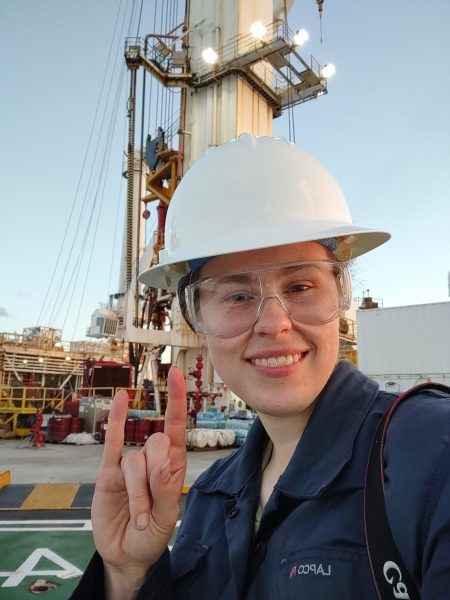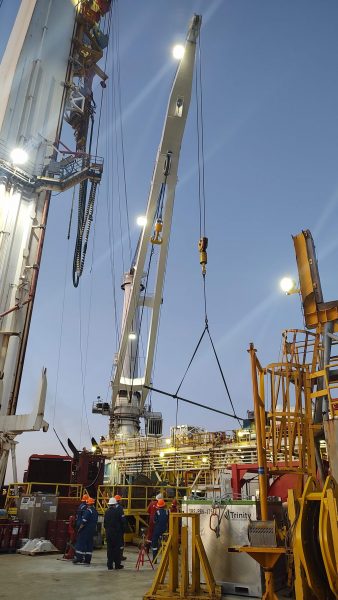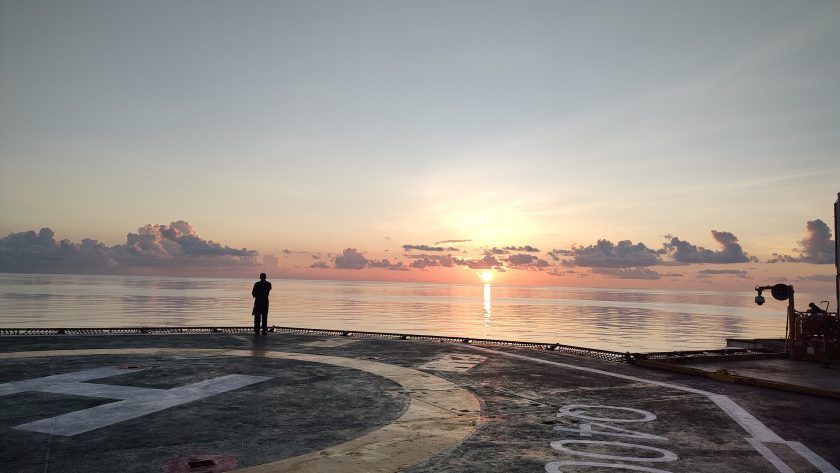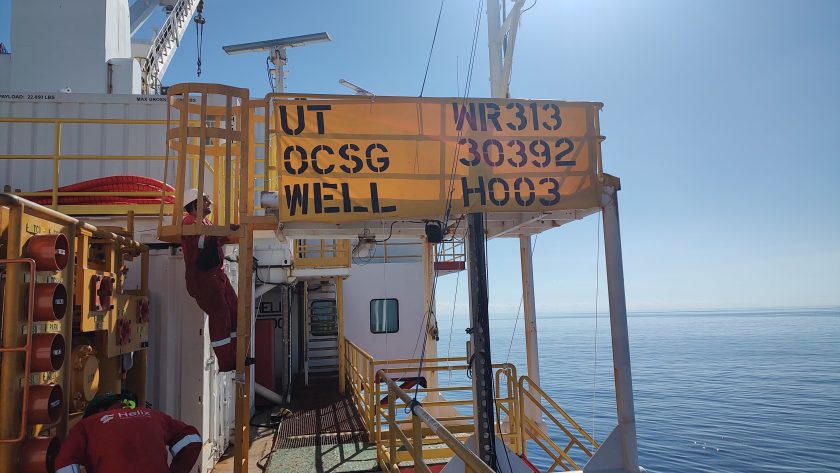The Stuff of Life at Sea
August 5, 2023
Editors Note: Scientists from the UT Jackson School of Geosciences and partner universities are in the Gulf of Mexico on a mission funded by the Department of Energy to sample and study methane hydrate, a difficult to reach and poorly understood substance with potentially wide-ranging effects on the planet’s environment, climate and energy resources. Led by Jackson School Professor Peter Flemings, the scientific team includes researchers from the U.S. Geological Survey, Ohio State University, the University of Washington, Oregon State University, the University of New Hampshire, the Colorado School of Mines and Tufts University. Jackson School Science Writer Monica Kortsha and videographer Drew Ott joined the team to document the work and tell the story. Follow the expedition here.
By Monica Kortsha

The mission to recover methane hydrates has scientists set on recovering core samples of the substance from over 1,000 feet beneath the seafloor. To actually reach these samples requires the science team to live and work aboard a specialized vessel named Helix Q4000.
I took the helicopter out to the Q4000 on Friday afternoon, shortly after the first core sample of the mission was successfully retrieved. While the scientists got to work analyzing the first core recovered for the mission, most of my day was spent getting acquainted with how life on the Q4000 works. I’m sharing some impressions here.
The Q4000 is not your usual research vessel. It was built to be a deepwater oil well drilling platform. For this mission, and an earlier one in 2017, its deepwater capabilities and drilling expertise are being put to use to core methane hydrate – an extremely carbon-dense form of frozen methane that could have significant impacts on the world’s climate and energy landscape.
A flag aboard the ship reading “UT WR313” lets passing vessels and aircraft know that, for this mission, the vessel is operated by The University of Texas at Austin. It’s most certainly the only platform in the Gulf with university backing. The “WR313” portion of the flag identifies the borehole, drilled years ago by a different mission, that the science team has selected to reenter to retrieve cores from a methane hydrate reservoir deep beneath the seafloor.
 The science happens in about a half-dozen white shipping containers outfitted into labs aboard the main platform. The coring happens at a station in the platform’s center overlooked by a large white crane that carries the drill pipes containing samples from the borehole to the deck. Once aboard, the core samples are removed from the pipe and slid into a hole cut into the first laboratory station for further analyses. The whole operation is surrounded by a mass of railings and stairs painted bright yellow and blue that rise up and crisscross the platform.
The science happens in about a half-dozen white shipping containers outfitted into labs aboard the main platform. The coring happens at a station in the platform’s center overlooked by a large white crane that carries the drill pipes containing samples from the borehole to the deck. Once aboard, the core samples are removed from the pipe and slid into a hole cut into the first laboratory station for further analyses. The whole operation is surrounded by a mass of railings and stairs painted bright yellow and blue that rise up and crisscross the platform.
Joining the scientists aboard are a professional drilling crew, vessel operations staff, and support staff to provide the day-to-day essentials. On a scientific drilling mission that operates 24-hours a day, those essentials come down to laundry and food. Laundry operates around the clock, and there’s a whole room devoted to detergent alone. Fresh-cooked meals are served 4 times a day – breakfast, lunch, dinner and midnight. Just today, dinner alone featured steak, tomato pasta, chicken, pork tenderloin, and rice and beans. To help beat the summer heat, Q4000 keeps a slushy-machine of Gatorade going on the main deck.
Scientists and drill crew work in 12-hour shifts and share sleeping quarters. Each quarter includes two bunk beds and a bathroom. The vessel has changing quarters so scientists and drilling crew can change from their casual clothing that’s worn below deck into the protective work gear that’s mandatory on the platform and in labs without waking their bunkmates. The half-dozen female scientists working on the UT-GOM2-2 mission led to the creation of the first women’s changing room aboard the Q4000.
The heliport where helicopters land also serves as the main spot for recreation and unwinding, for both the drilling crew and the science team. On Friday evening, a group of scientists gathered to view the green “spark” that can be seen when the sun dips below the horizon, but was thwarted at the last minute by a small cloud right in the line of sight. The stacks of lavender clouds over the calm blue ocean were still a beautiful sight to behold.
For the scientists aboard, the most satisfying sight of the evening was probably the nine-meter-long drill pipe floating across the night sky as it was moved into position in front of the receiving lab. It was the second core of the mission, something for the midnight science crew to start analyzing.
This is the first post on a series. Read the second post here.


